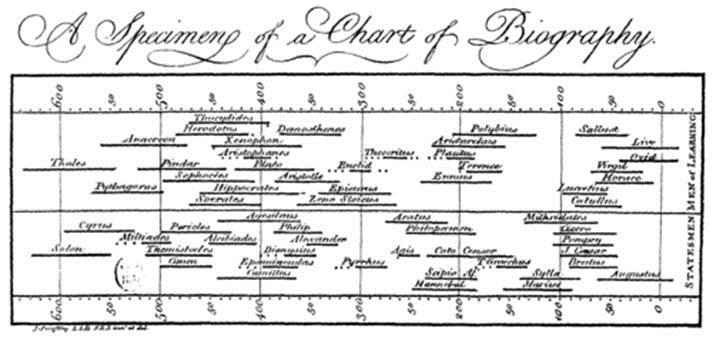As a boy growing up in the 1970s, I was fascinated in particular by dinosaurs. I knew all their names, Tyrannosaurus Rex, Diplodocus, Triceratops etc. And I could also remember in which geological time period they lived, and on which continent; and what they ate, often each other of course!
To work all this out, I would pore over colourful time charts, with millions of years BC on one axis and types of dinosaurs shown as long rivers of colour. When they first appeared, and when they died out. Such charts had been around for a very long time, and were generally used to how when famous people such Plato, or Napoleon had lived. The first one in fact appeared in 1765 and was designed by Joseph Priestley.
Although highly innovative, Priestley’s chart was not especially full of data. It took another 20 years for the first real data visualisation to be produced.
From storming the Bastille to inventing the bar chart
William Playfair was certainly an unusual character, with a highly unusual career. Born in Dundee (Scotland) in 1759, he tried his hand at a range of jobs including millwright, accountant, silversmith, investment broker, statistician, writer, translator, convict, blackmailer and journalist! He set up a silversmith’s in London, which failed, as did his bank; but took time to head over to Paris to help storm the Bastille!
Not exactly a household name (well I’d never heard of him before writing this blog post), but he made three crucial inventions which shape our lives today, especially if we are SAS users. Namely, the humble bar chart, pie chart and line chart. Below is the first ever published bar chart, showing Scottish imports and exports, compared to a similar chart created using PROC GCHART for 2011 just showing exports.

It is interesting to note that the most advanced and flexible of modern analytical tools, namely SAS Visual Analytics, still use that basic bar chart concept to this very day.
Historical images shared from Wikipedia with permission via cc license.


5 Comments
Michael Friendly has published several articles on the history of graphical visualization. He also maintains a graphics gallery with "milestones" for significant acheivements in the field. Both Friendly and Tufte (VDQI) credit a time series of planetary motion as being the oldest known example of a statistical graphic. See Fig 2 (p. 4) of Friendly's "A brief history of data visualization"
Won't debate the first, but Minard's map of Napoleans's march to, and retreat from Russia, as popularized by Tufte is an incredible piece of work. Something like 7 seven dimensions are displayed.
This is probably the definitive answer to the question:
http://www.datavis.ca/papers/langren-TAS09154.pdf
"The First (Known) Statistical Graph: Michael Florent van Langren and the “Secret” of Longitude" by Michael FRIENDLY, Pedro VALERO-MORA, and Joaquín IBÁÑEZ ULARGUI
Professor Friendly is at York University in Toronto, and might have been the author of the first SAS book by a user: "SAS System for Statistical Graphics". His second SAS book was "Visualizing Categorical Data", a very nice piece of work, printed in color.
If anyone wants to benefit from practical data visualization wisdom,
see his web site http://www.datavis.ca/gallery/
Philip:
If you are going to write a blog post titled "The first data visualization," at the very least you
should make sure you have your details right so you are not embarrassed.
Joseph Priestley (author of the specimen chart you show) != William Priestley.
This is just sloppy, and should probably be retracted or revised, lest it look publicly
like SAS bloggers are careless and ill-informed.
Moreover, it is just plain dumb to write about "The first data visualization,"
(of what? there is a long, nuanced history I have documented, http://datavis.ca/milestone) .
Could this be worse? Yes --confessing to know nothing about Playfair, you proceed to claim him
as your protagonist and then say that " SAS Visual Analytics still uses Playfair’s basic concept to this very day."
Thanks for the link to your site, Michael, and thanks for your efforts to document the history of data visualization so thoroughly.
As the editor of this blog, I'd like to apologize for the William/Joseph name mix up. I should have caught that.
I do think this post was written in the spirit of starting a conversation and telling a story. I've made a few additional edits to make that more clear, since I think the author was trying to share a childhood anecdote and show how it related to his job today, not to claim sole expertise in the area.
-Alison